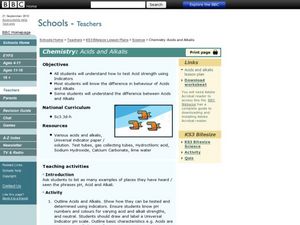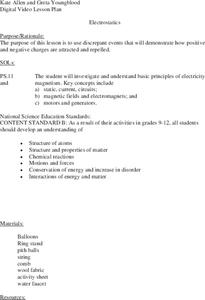Pingry School
Kinetics of the Acid Decomposition of Thiosulfate
Several factors affect the rate of a chemical reaction including temperature, surface area, and concentration. Using an experimental approach, learners explore the effect concentration has on this rate while maintaining consistency with...
Curated OER
The Atom Board - Making Atoms
In this atom worksheet, chemists learn how to determine the number of protons, neutrons and electrons in an atom using the atomic mass and atomic number. They complete a chart of the subatomic particles and use marbles to represent...
Curated OER
Water Filtration
As an example of nature's water filtering system, young ecologists conduct an experiment in the lab. They construct a funnel out of a plastic bottle, fill it with specified layers of materials that simulate layers of soil, then run muddy...
South Pasadena AP Chemistry
Acid-Base Equilibria: pH Practice
Across the top of the page is a large Z diagram representing varying degrees of acid-base equilibria. Advanced chemistry classes answer eight questions using the values listed for the H+ and the OH- ions that are part of the...
National Institute of Open Schooling
Radioactive Pollution
Radioactive pollutants can enter the body through ingestion, inhalation, absorption, or injection. The last lesson in a series of 36 introduces pupils to radioactive pollution. They study its sources, both natural and man-made, its...
National Institute of Open Schooling
p-Block Elements and Their Compounds – II
Ozone, made of three bonded oxygen atoms, is found 15-30 km above Earth, has a strong smell, is blue, and blocks sunlight from hitting the surface of Earth. The 22nd lesson in a series of 36 specifically focuses on the important elements...
National Institute of Open Schooling
Ionic Equilibrium
Scientific studies show the older we get, the more acidic we become. The activity extensively teaches high schoolers about acids and bases. By the end of the 14th installment of 36, they can define and explain three concepts of...
DiscoverE
Water Pollution Cleanup
How do scientists determine the best method for removing pollutants from our water sources? Environmental scholars experiment with pollution clean-up options to discover which are the most cost-effective, fastest, and most thorough....
Curated OER
Debates On Important Court Cases
High schoolers debate important court cases. Divided into three groups, students accept a position as first debater, second debater and the third group is neutral. At the conclusion of each debate, high schoolers vote to determine the...
Curated OER
Acid (and Base) Rainbows
Pupils are introduced to the differences between acids and bases and how to use indicators, such as pH paper and red cabbage juice, to distinguish between them. They make predictions that can be answered through scientific investigation,...
Curated OER
Solutions
In this solutions worksheet, students determine the pH or molar solubility of different solutions. Students state is the mixture given forms a buffer. This worksheet has 20 problems to solve.
Curated OER
Squirrel Islands
In this adaptations worksheet, students read about 3 species that have changed over time to adapt to their environment. Students design a squirrel that has adapted to an island habitat that students are assigned. They describe the...
Curated OER
pH and Red Cabbage Juice
Students review properties of materials and define what pH tells them about matter. In this pH levels lesson, students determine whether materials are acids or bases using indicator substances.
Curated OER
Chemistry: Acids and Alkalis
Young scholars identify substances that are acids and alkalis. In this acids and alkalis lesson, students conduct tests to determine if given substances are acids or alkalis. They test substances and explain the different qualities that...
Code.org
Practice PT - The Internet and Society
Speaking of the Internet. The culminating instructional activity for the unit on the Internet challenges pupils to prepare short, two-minute speeches on an issue facing society. The pupils chose from three topics that connect...
Curated OER
Types of Chemical Reactions
This PowerPoint presentation is sure to support your lesson on chemical reactions. Colorful diagrams and pictures, solubility tables and rules, clever animations and diagrams make teaching these concepts a cinch! Your chemistry...
Curated OER
Identification of Gram Negative Bacilli-IMViC
For this microbiology worksheet, students complete 9 review questions after finishing a group lab in which they perform four biochemical tests to help divide the Enterobacteriaceae into two major groups- E. coli and...
Curated OER
Aqueous Acids and Bases - Titration
In this titration worksheet, students determine the moles of product plus the molarity of the solution created. This worksheet has 6 problems to solve.
Curated OER
Household Electricity
Practice reading an analogue meter in this PowerPoint about energy consumption. The equations connecting voltage and current, work force, and distance are given. Then household energy consumption is described. The slides will prompt much...
Curated OER
Ionic bonding
Learners explore ionic bonding. They draw examples of ionic bonding and explain the activities of the electrons of the elements. Students use paper plates and candy to draw electron configurations of given atoms.
Curated OER
Electrostatics
Middle schoolers examine ways positive and negative charges are attracted and repelled by watching teacher demonstrations, and complete activity sheet related to classroom demonstration activities to prove proficiency of knowledge of...
Curated OER
Bringing The Greenhouse Effect Down To Earth (CO2 experiment)
Students compare 4 different form of carbon dioxide and discuss the role that carbon dioxide has in the Greenhouse Effect. They then understand that the Greenhouse Effect is a naturally occurring event.
Curated OER
Periodic Trends
Thorough explanations of the trends in the periodic table of elements make up the majority of this handout. Atomic and ionic size, ionization energy, electron affinity, and electronegativity are presented before giving chemistry...
Curated OER
Solutions
In this solutions worksheet, students calculate the pH of given solutions. Students determine the equation used to determine pH and the estimated pH for mixtures. This worksheet has 12 fill in the blank and 15 problems to solve.























